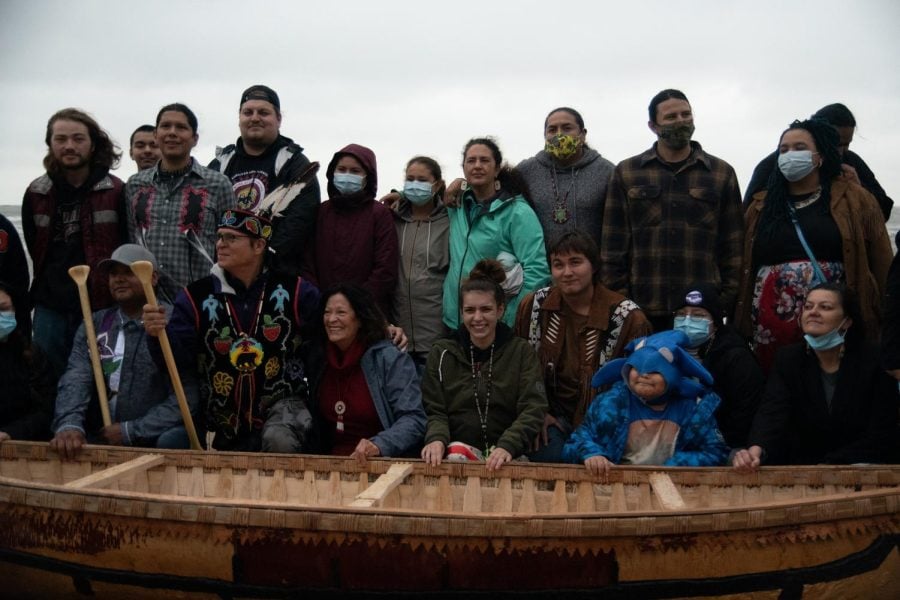Artist and community members celebrate Anishinaabe heritage and creation of Birch bark canoe at Lake Michigan
Angeli Mittal/Daily Senior Staffer
Valliere and his team carry the canoe away from the lake after the planned launch.
October 31, 2021
For the first time in nearly 400 years, a birch bark canoe was reintroduced to the Chicago-area shore of Lake Michigan (Mishigami).
Only six Ojibwe birch bark canoe builders still exist in the Great Lakes region, according to artist Wayne Valliere (Mino-Giizhig), a Lac Du Flambeau Ojibwe. The launch site on Northwestern’s campus is home to the Council of Three Fires, an alliance of the Ojibwe, Potawatomi and Ottawa tribes.
“(Being here) is like homecoming to us Anishinaabe people,” Valliere said. “And Lake (Michigan) knows our people.”
Valliere, his team of apprentices and members of the NU and Evanston community were expected to set the canoe in Lake Michigan on Friday at sunrise, but windy conditions prevented them from doing so. The event was a culmination of a month of building and nearly one and a half years of gathering material.
Valliere said he and his apprentices gathered white paper birch, spruce root, cedar, basswood and spruce gum, among other materials, in Wisconsin prior to the COVID-19 pandemic. His language apprentice and Ojibwe member Jeffery Cisneros (Ogiimaa) said gathering material was the most difficult part of building the canoe.
“(We hauled) a huge cedar tree that weighed like 400 pounds … split it up and carried it out of the swamp,” Cisneros said. “You get sucked into the mud, and it was really hot out there.”
Environmental awareness is central to the process, Valliere said, which is why he built the canoe out of solely organic materials. He said it is part of Anishinaabe culture to maintain Grandmother Earth for future generations to come.
Valliere added the natural world is not preserved to its fullest extent today. He said he and his apprentices give back to the environment in exchange for its resources.
“We never just take, we always put something back in return,” Valliere said. “And we never overharvest.”
Medill senior Eddie Peabody worked on the canoe along with a team of NU students and Evanston community members. He said he learned about Valliere’s project in “Native American Environmental Issues and the Media” taught by Medill Prof. Patty Loew, a longtime friend of Valliere’s.
Peabody said his experience helping the Tulalip tribe fish near his grandmother’s house outside Seattle drew him to the project. He added he initially joined Valliere and his team to document the process digitally.
“I quickly realized that … there were opportunities to help, so I put the camera down,” Peabody said. “From then on, it became far too easy to forget about filming at all … (building the canoe) is such a rewarding endeavor.”
Peabody is one of many NU students who helped build the canoe, some of whom are Anishinaabe themselves.
Valliere said he is proud to see Anishinaabe students at NU. He added his dedication to working with students stems from guidance from his elders who taught him canoe building, and he hopes to pass the practice on to the next generation.
“It was a responsibility (for elders) to teach me these things, and a promise was made at that time that I would also pass this knowledge on,” Valliere said. “It’s part of the identity of the Anishinaabe people, and these canoes carry our culture.”
Email: [email protected]
Twitter: @swarthout_iris
Related Stories:
— Defining Safe: The Path to a Minor in Native American and Indigenous Studies
— Media educator Ernest M. Whiteman III speaks about Native American media representation



